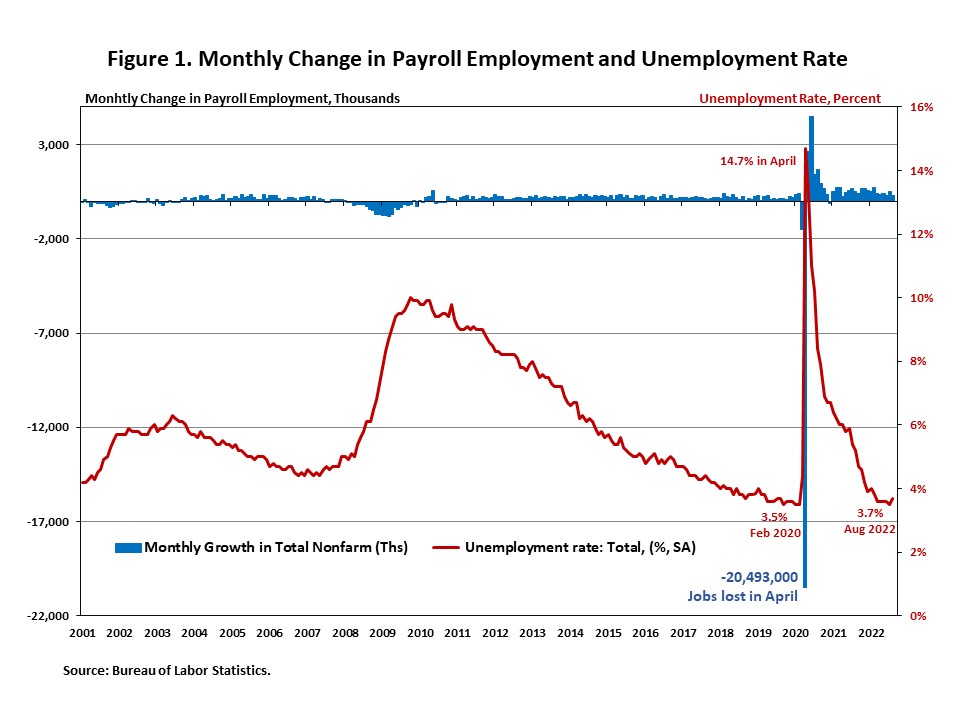Job growth remained solid in August, with 315,000 net job growth. However, the unemployment rate rose 0.2 percentage points to 3.7% in August, as the labor market participation rate expanded. “Softer labor market conditions” are expected in the near future as the Fed raises interest rates aggressively into 2023 to bring inflation lower. The headline job number of today’s labor market report raises the likelihood of a 75 basis point increase for the federal funds rate by the Fed in September.
Construction industry employment (both residential and non-residential) totaled 7.7 million in August, exceeding its February 2020 level. In August, residential construction gained 10,900 jobs, and non-residential construction added 4,300 jobs. Residential construction employment currently exceeds its level in February 2020, while 82% of non-residential construction jobs lost in March and April have now been recovered.

Total nonfarm payroll employment increased by 315,000 in August, following a gain of 526,000 in July, as reported in the Employment Situation Summary. The estimates for the previous two months were revised down. The June estimate was revised down by 105,000 from +398,000 to +293,000, while the July increase was revised down by 2,000. With these revisions, employment in June and July together was revised down by 107,000 from the previously reported ones.
In the first eight months of 2022, more than 3.5 million jobs were created, and monthly employment growth averaged 438,000 per month. As of August 2022, total nonfarm employment is back to pre-pandemic level in February 2020, meaning U.S. labor market is fully recovered from the COVID-19 pandemic.
Meanwhile, the unemployment rate rose by 0.2 percentage points to 3.7% in August. It has returned to its February 2020 level as of July. In August, the number of unemployed persons increased by 344,000 to 6.0 million. Meanwhile, the labor force participation rate, the proportion of the population either looking for a job or already with a job, ticked up 0.3 percentage points to 62.4% in August. This month’s increase in the labor force participation rate reflected a 786,000 increase for the total of the civilian labor force and a 613,000 decrease in the number of persons not in the labor force. Moreover, the labor force participation rate for people who aged between 25 and 54 increased to 82.8% in August.

Professional and business services (+68,000), health care (+48,000) and retail trade (+44,000) had notable job gains in August.
Employment in the overall construction sector increased by 16,000 in August, following a 24,000 gain in July. Residential construction gained 10,900 jobs, while non-residential construction employment gained 4,300 jobs in August.
Residential construction employment now stands at 3.2 million in August, broken down as 904,000 builders and 2.3 million residential specialty trade contractors. The 6-month moving average of job gains for residential construction was 8,533 a month. Over the last 12 months, home builders and remodelers added 118,700 jobs on a net basis. Since the low point following the Great Recession, residential construction has gained 1,194,100 positions.
In August, the unemployment rate for construction workers rose by 1.1 percentage points to 5.0% on a seasonally adjusted basis but was still close to the lowest point within the past 20 years. The unemployment rate for construction workers has been trending lower, after reaching 14.2% in April 2020, due to the housing demand impact of the COVID-19 pandemic.

Related


